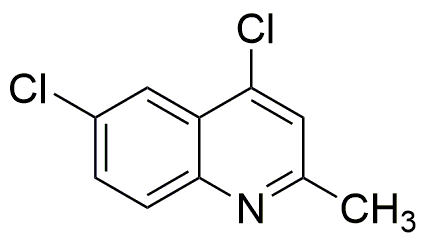4,6-Dichloro-2-methylquinoline is widely utilized in research focused on:
- Pharmaceutical Development: This compound is a key intermediate in the synthesis of various pharmaceuticals, particularly in developing antimicrobial agents. Its unique structure allows for modifications that enhance efficacy against resistant bacterial strains.
- Agricultural Chemicals: It serves as a precursor in the formulation of agrochemicals, including herbicides and fungicides, helping to improve crop yield and protect against pests while minimizing environmental impact.
- Material Science: The compound is used in creating specialized coatings and polymers, providing enhanced durability and resistance to environmental degradation, which is crucial for applications in construction and automotive industries.
- Research in Biochemistry: It is employed in various biochemical assays and studies, particularly in exploring enzyme inhibition mechanisms, which can lead to breakthroughs in understanding metabolic pathways.
- Analytical Chemistry: The compound is utilized as a standard in chromatographic techniques, aiding in the accurate analysis of complex mixtures in both industrial and research settings.
Informations générales
Propriétés
Sécurité et réglementation
Applications
4,6-Dichloro-2-methylquinoline is widely utilized in research focused on:
- Pharmaceutical Development: This compound is a key intermediate in the synthesis of various pharmaceuticals, particularly in developing antimicrobial agents. Its unique structure allows for modifications that enhance efficacy against resistant bacterial strains.
- Agricultural Chemicals: It serves as a precursor in the formulation of agrochemicals, including herbicides and fungicides, helping to improve crop yield and protect against pests while minimizing environmental impact.
- Material Science: The compound is used in creating specialized coatings and polymers, providing enhanced durability and resistance to environmental degradation, which is crucial for applications in construction and automotive industries.
- Research in Biochemistry: It is employed in various biochemical assays and studies, particularly in exploring enzyme inhibition mechanisms, which can lead to breakthroughs in understanding metabolic pathways.
- Analytical Chemistry: The compound is utilized as a standard in chromatographic techniques, aiding in the accurate analysis of complex mixtures in both industrial and research settings.
Documents
Fiches de données de sécurité (FDS)
La FDS fournit des informations de sécurité complètes sur la manipulation, le stockage et l’élimination du produit.
Spécifications du produit (PS)
Le PS fournit une description complète des propriétés du produit, notamment sa composition chimique, son état physique, sa pureté et les exigences de stockage. Il détaille également les plages de qualité acceptables et les applications prévues du produit.
Certificats d'analyse (COA)
Recherchez des certificats d'analyse (COA) en saisissant le numéro de lot du produit. Les numéros de lot et de lot se trouvent sur l'étiquette d'un produit, après les mots « Lot » ou « Lot de fabrication ».
Numéro de catalogue
Numéro de lot/série
Certificats d'origine (COO)
Ce certificat d'exploitation confirme le pays dans lequel le produit a été fabriqué, et détaille également les matériaux et composants utilisés et s'il est issu de sources naturelles, synthétiques ou autres sources spécifiques. Ce certificat peut être requis pour les douanes, le commerce et la conformité réglementaire.
Numéro de catalogue
Numéro de lot/série
Fiches de données de sécurité (FDS)
La FDS fournit des informations de sécurité complètes sur la manipulation, le stockage et l’élimination du produit.
DownloadSpécifications du produit (PS)
Le PS fournit une description complète des propriétés du produit, notamment sa composition chimique, son état physique, sa pureté et les exigences de stockage. Il détaille également les plages de qualité acceptables et les applications prévues du produit.
DownloadCertificats d'analyse (COA)
Recherchez des certificats d'analyse (COA) en saisissant le numéro de lot du produit. Les numéros de lot et de lot se trouvent sur l'étiquette d'un produit, après les mots « Lot » ou « Lot de fabrication ».
Numéro de catalogue
Numéro de lot/série
Certificats d'origine (COO)
Ce certificat d'exploitation confirme le pays dans lequel le produit a été fabriqué, et détaille également les matériaux et composants utilisés et s'il est issu de sources naturelles, synthétiques ou autres sources spécifiques. Ce certificat peut être requis pour les douanes, le commerce et la conformité réglementaire.


